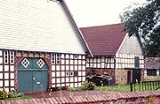
Fachhallenhaus
Encyclopedia
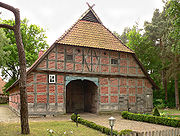

Timber framing
Timber framing , or half-timbering, also called in North America "post-and-beam" construction, is the method of creating structures using heavy squared off and carefully fitted and joined timbers with joints secured by large wooden pegs . It is commonplace in large barns...
farmhouse, which combines living quarters, byre and barn under one roof.. It is built as a large hall with bays on the sides for livestock and storage and with the living accommodation at one end. The Low German house appeared during the 13th to 15th centuries and was referred to as the Low Saxon house (Niedersachsenhaus) in early research works. Until its decline in the 19th century, this rural, agricultural farmhouse style was widely distributed through the North German Plain
North German plain
The North German Plain or Northern Lowland is one of the major geographical regions of Germany. It is the German part of the North European Plain...
, all the way from the Lower Rhine
Lower Rhine
The Lower Rhine flows from Bonn, Germany, to the North Sea at Hoek van Holland, Netherlands.Almost immediately after entering the Netherlands, the Rhine splits into many branches. The main branch is called the Waal which flows from Nijmegen to meet the river Meuse; after which it is called Merwede...
to Mecklenburg
Mecklenburg
Mecklenburg is a historical region in northern Germany comprising the western and larger part of the federal-state Mecklenburg-Vorpommern...
. Even today, the Fachhallenhaus still characterises the appearance of many north German villages.
Name
The German name Fachhallenhaus is a regional variation of the term Hallenhaus ("hall house", sometimes qualified as the "Low Saxon hall house"). In the academic definition of this type of house the word Fach does not refer to the Fachwerk or "timber-framing" of the walls, but to the large Gefach or "bay" between two pairs of the wooden posts (Ständer) supporting the ceiling of the hall and the roof which are spaced about 2.5 metres (8.2 ft) apart. This was also used as a measure of house size: the smallest only had 2 bays, the largest, with 10 bays, were about 25 metres (82 ft) long. The term Halle ("hallHall
In architecture, a hall is fundamentally a relatively large space enclosed by a roof and walls. In the Iron Age, a mead hall was such a simple building and was the residence of a lord and his retainers...
") refers to the large open threshing area or Diele (also Deele or Deel) formed by two rows of posts. The prefix Niederdeutsch ("Low German
Low German
Low German or Low Saxon is an Ingvaeonic West Germanic language spoken mainly in northern Germany and the eastern part of the Netherlands...
") refers to the region in which they were found mainly found. Because almost all timber-framed and hall-type farmhouses were divided into so-called Fache (bays), the prefix Fach appears superfluous.
The academic name for this type of house comes from the German
German language
German is a West Germanic language, related to and classified alongside English and Dutch. With an estimated 90 – 98 million native speakers, German is one of the world's major languages and is the most widely-spoken first language in the European Union....
words "Fach" (bay), describing the space (up to 2.5 metres (8.2 ft)) between trusses made of two rafters fixed to a tie beam and connected to two posts with braces and "Halle", meaning something like hall as in a hall church
Hall church
A hall church is a church with nave and side aisles of approximately equal height, often united under a single immense roof. The term was first coined in the mid-19th century by the pioneering German art historian Wilhelm Lübke....
. The walls were usually timber-framed made of posts and rails; the panels (Gefache) in between are filled with wattle and daub or bricks. One bay may be two or rarely three Gefache wide.
Alternative names
In the past other names were commonly used for this type of farmhouse, derived either from their design or the region in which they were built:- Flett-Deelen-Haus (a Hallenhaus) with a very common floorplan including an open kitchen or Flett to the side of the Deele
- Kübbungshaus (Hallenhaus of two-post construction, also called a Zweiständerhaus, named after the non-load-bearing side bays or Kübbungen)
- Niedersachsenhaus (Low Saxon house)
- Sächsisches Haus (Saxon house)
- Altsächsisches Bauernhaus (Old Saxon farmhouse)
- Westfälisches Bauernhaus (Westphalian farmhouse)
- Westfalenhaus (Westphalian house)
Niedersachsenhaus is the most widespread and commonly used term, even though it is not strictly correct from an academic point of view.
Other terms
Because this type of farm combines living quarters, stalls and hay storage under one roof it is also described as an Einhaus ("single house" or "all-in-one house") and the attached farmyard as an Eindachhof ("single-roofed farmyard"). A special feature of the Low German house is its longitudinal division, also referred to as dreischiffige or "triple-aisled". This is considerably different from all-in-one farmhouses elsewhere in Germany and Europe which are built with traditional transverse divisions, as in the Ernhaus, not to mention other common farm layouts where the farm comprises several buildings with different functions, usually around a farmyard.Early history
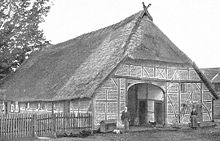
Middle Ages
The Middle Ages is a periodization of European history from the 5th century to the 15th century. The Middle Ages follows the fall of the Western Roman Empire in 476 and precedes the Early Modern Era. It is the middle period of a three-period division of Western history: Classic, Medieval and Modern...
. Only a few years ago a Hallenhaus was discovered in the Dutch province of Drenthe
Drenthe
Drenthe is a province of the Netherlands, located in the north-east of the country. The capital city is Assen. It is bordered by Overijssel to the south, Friesland to the west, Groningen to the north, and Germany to the east.-History:Drenthe, unlike many other parts of the Netherlands, has been a...
, the frame of which can be dated to 1386. The oldest surviving houses of this type in Germany date to the late 15th century (e.g. in Schwinde, Winsen Elbe Marsh 1494/95). Regional differences arose due to the need to adapt to local farming and climatic conditions. The design also changed over time and was appropriate to its owner's social class. From the outset, and for a long time thereafter, people and animals were accommodated in different areas within a large room. Gradually the living quarters were separated from the working area and animals. The first improvements were separate sleeping quarters for the farmer and his family at the rear of the farmhouse. Sleeping accommodation for farmhands and maids was created above (in Westphalia) or next to (in Lower Saxony and Holstein) the livestock stalls at the sides. Finished linen, destined for sale, was also stored in a special room. As the demand for comfort and status increased, one or more rooms would be heated. Finally the stove was moved into an enclosed kitchen rather than being in a Flett or open hearth at the end of the hall.
Predecessors
The Low German house is similar in construction to the neolithicNeolithic
The Neolithic Age, Era, or Period, or New Stone Age, was a period in the development of human technology, beginning about 9500 BC in some parts of the Middle East, and later in other parts of the world. It is traditionally considered as the last part of the Stone Age...
longhouse, although there is no evidence of a direct connexion. The longhouse first appeared during the period of the Linear Pottery culture
Linear Pottery culture
The Linear Pottery culture is a major archaeological horizon of the European Neolithic, flourishing ca. 5500–4500 BC.It is abbreviated as LBK , is also known as the Linear Band Ware, Linear Ware, Linear Ceramics or Incised Ware culture, and falls within the Danubian I culture of V...
about 7,000 years ago and has been discovered during the course of archaeological excavations in widely differing regions across Europe, including the Ville ridge west of Cologne
Cologne
Cologne is Germany's fourth-largest city , and is the largest city both in the Germany Federal State of North Rhine-Westphalia and within the Rhine-Ruhr Metropolitan Area, one of the major European metropolitan areas with more than ten million inhabitants.Cologne is located on both sides of the...
. The longhouse differed from later types of house in that it had a central row of posts under the roof ridge. It was therefore not three- but four-aisled. To start with, cattle were kept outside overnight in Hürden or pens. With the transition of agriculture to permanent fields the cattle were brought into the house, which then became a so-called Wohnstallhaus or byre-dwelling.
Later the centre posts were omitted to form a triple-aisled longhouse (dreischiffigen Langhaus, often a dreischiffigen Wohnstallhaus) that could be found in almost all of northwest Europe in the Early Middle Ages
Early Middle Ages
The Early Middle Ages was the period of European history lasting from the 5th century to approximately 1000. The Early Middle Ages followed the decline of the Western Roman Empire and preceded the High Middle Ages...
. Its roof structure rested as before on posts set into the ground and was therefore not very durable or weight-bearing. As a result these houses already had rafter
Rafter
A rafter is one of a series of sloped structural members , that extend from the ridge or hip to the downslope perimeter or eave, designed to support the roof deck and its associated loads.-Design:...
s, but no loft to store the harvest. The outer walls were only made of wattle and daub
Wattle and daub
Wattle and daub is a composite building material used for making walls, in which a woven lattice of wooden strips called wattle is daubed with a sticky material usually made of some combination of wet soil, clay, sand, animal dung and straw...
(Flechtwerk).
By the Carolingian era, houses built for the nobility had their wooden, load-bearing posts set on foundations of wood or stone. Such uprights, called Ständer, were very strong and lasted several hundred years. These posts were first used for farmhouses in northern Germany from the 13th century, and enable them to be furnished with a load-bearing loft. In the 15th and 16th centuries the design of the timber-framing was further perfected.
Distribution
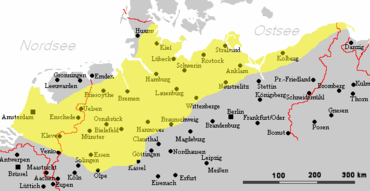
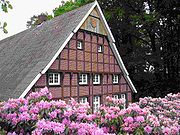
Netherlands
The Netherlands is a constituent country of the Kingdom of the Netherlands, located mainly in North-West Europe and with several islands in the Caribbean. Mainland Netherlands borders the North Sea to the north and west, Belgium to the south, and Germany to the east, and shares maritime borders...
where the height of gable and loft are usually lower, mirroring its development over time from self-sufficiency to market-oriented farming. From the Lower Rhine
Lower Rhine
The Lower Rhine flows from Bonn, Germany, to the North Sea at Hoek van Holland, Netherlands.Almost immediately after entering the Netherlands, the Rhine splits into many branches. The main branch is called the Waal which flows from Nijmegen to meet the river Meuse; after which it is called Merwede...
region to western Mecklenburg the Low German house was the dominant type of farmhouse. Further east it was found as far as the Danzig Bay, but manor house
Manor house
A manor house is a country house that historically formed the administrative centre of a manor, the lowest unit of territorial organisation in the feudal system in Europe. The term is applied to country houses that belonged to the gentry and other grand stately homes...
s (Gutshaus) and farm workers houses were more common. In Schleswig-Holstein
Schleswig-Holstein
Schleswig-Holstein is the northernmost of the sixteen states of Germany, comprising most of the historical duchy of Holstein and the southern part of the former Duchy of Schleswig...
it was found mostly south of the Eider river
Eider River
The Eider is the longest river of the German state of Schleswig-Holstein. The river starts near Bordesholm and reaches the southwestern outskirts of Kiel on the shores of the Baltic Sea, but flows to the west, ending in the North Sea...
, the old border with Denmark
Denmark
Denmark is a Scandinavian country in Northern Europe. The countries of Denmark and Greenland, as well as the Faroe Islands, constitute the Kingdom of Denmark . It is the southernmost of the Nordic countries, southwest of Sweden and south of Norway, and bordered to the south by Germany. Denmark...
. In northern Sauerland
Sauerland
The Sauerland is a rural, hilly area spreading across most of the south-eastern part of North Rhine-Westphalia, in parts heavily forested and, apart from the major valleys, sparsely inhabited...
and the Weser Uplands there was less of a sharp boundary and more of a gradual reduction in floor area as the terrain became hillier. In southern Lower Saxony
Lower Saxony
Lower Saxony is a German state situated in north-western Germany and is second in area and fourth in population among the sixteen states of Germany...
the Hessian
Hesse
Hesse or Hessia is both a cultural region of Germany and the name of an individual German state.* The cultural region of Hesse includes both the State of Hesse and the area known as Rhenish Hesse in the neighbouring Rhineland-Palatinate state...
square farmstead (Vierkanthof) is found well inside the Low German language area. In east Lower Saxony the Niedersachsenhaus and the square farmstead are interspersed like a mosaic. In Saxony-Anhalt
Saxony-Anhalt
Saxony-Anhalt is a landlocked state of Germany. Its capital is Magdeburg and it is surrounded by the German states of Lower Saxony, Brandenburg, Saxony, and Thuringia.Saxony-Anhalt covers an area of...
there are none in the Magdeburg Börde and only a few in the Altmark
Altmark
The Altmark is a historic region in Germany, comprising the northern third of Saxony-Anhalt. As the initial territory of the Brandenburg margraves, it is sometimes referred to as the "Cradle of Prussia", as by Otto von Bismarck, a native from Schönhausen near Stendal.- Geography :The Altmark is...
.
This style of house typically appears in the following regions:
|
Lower Saxony Lower Saxony is a German state situated in north-western Germany and is second in area and fourth in population among the sixteen states of Germany... Holstein Holstein is the region between the rivers Elbe and Eider. It is part of Schleswig-Holstein, the northernmost state of Germany.... Prignitz Prignitz is a Kreis in the northwestern part of Brandenburg, Germany. Neighboring are the district Ludwigslust-Parchim in Mecklenburg-Western Pomerania, the district Ostprignitz-Ruppin in Brandenburg, the district Stendal in Saxony-Anhalt and the district Lüchow-Dannenberg in Lower... |
Altmark The Altmark is a historic region in Germany, comprising the northern third of Saxony-Anhalt. As the initial territory of the Brandenburg margraves, it is sometimes referred to as the "Cradle of Prussia", as by Otto von Bismarck, a native from Schönhausen near Stendal.- Geography :The Altmark is... Mecklenburg Mecklenburg is a historical region in northern Germany comprising the western and larger part of the federal-state Mecklenburg-Vorpommern... |
The Low German house occurs more or less in the areas settled by the Germanic
Germanic peoples
The Germanic peoples are an Indo-European ethno-linguistic group of Northern European origin, identified by their use of the Indo-European Germanic languages which diversified out of Proto-Germanic during the Pre-Roman Iron Age.Originating about 1800 BCE from the Corded Ware Culture on the North...
tribes of the Saxons
Saxons
The Saxons were a confederation of Germanic tribes originating on the North German plain. The Saxons earliest known area of settlement is Northern Albingia, an area approximately that of modern Holstein...
, thus leading its popular name, Low Saxon House, or Niedersachsenhaus, which is based on the Old Saxon
Saxons
The Saxons were a confederation of Germanic tribes originating on the North German plain. The Saxons earliest known area of settlement is Northern Albingia, an area approximately that of modern Holstein...
cultural region of Low Germany.
Regional features
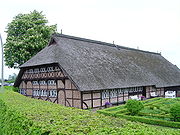
Altes Land
Altes Land is an area of reclaimed marshland straddling parts of Lower Saxony and Hamburg. The region is situated downstream from Hamburg on the southwestern riverside of the Elbe around the towns of Stade, Buxtehude, Jork and the Samtgemeinde of Lühe...
near Stade
Stade
Stade is a city in Lower Saxony, Germany and part of the Hamburg Metropolitan Region . It is the seat of the district named after it...
. On these, the gable facing the road were steeply pitched, made of coloured brickwork and is often projecting. In addition the facades were decorated with neoclassical
Neoclassical architecture
Neoclassical architecture was an architectural style produced by the neoclassical movement that began in the mid-18th century, manifested both in its details as a reaction against the Rococo style of naturalistic ornament, and in its architectural formulas as an outgrowth of some classicizing...
and renaissance
Renaissance
The Renaissance was a cultural movement that spanned roughly the 14th to the 17th century, beginning in Italy in the Late Middle Ages and later spreading to the rest of Europe. The term is also used more loosely to refer to the historical era, but since the changes of the Renaissance were not...
designs of the Gründerzeit
Gründerzeit
' refers to the economic phase in 19th century Germany and Austria before the great stock market crash of 1873. At this time in Central Europe the age of industrialisation was taking place, whose beginnings were found in the 1840s...
which lasted to about 1871. Gable design and decorations go back to the area of Hamburg. Another particularly impressive regional variation is the Low German house is found in the Artland
Artland
Artland is a Samtgemeinde in the district of Osnabrück, in Lower Saxony, Germany. It is situated along the river Hase, approx. 45 km north of Osnabrück, and 25 km west of Vechta. Its seat is the town Quakenbrück....
near Osnabrück.
See also: Rieck-Huus on Low German Wikipedia
Neighbouring farmhouse types
On the southern boundary of the Low German house region, as well as the multi-sided farmsteads, there is the historical Ernhaus type of farm, also referred to as the Middle German house (mitteldeutsches Haus) or Frankish farmstead (fränkisches Haus). A northern neighbour of the Fachhallenhaus in the immediate vicinity of the North Sea coast was the Gulf houseGulf house
A Gulf house , also called a Gulf farmhouse or East Frisian house , is a type of farmhouse that emerged in the 16th and 17th centuries in North Germany. It is timber-framed and built using post-and-beam construction. Initially Gulf houses appeared in the marshes, but later spread to the Frisian...
(Gulfhaus) or Frisian farmstead (Ostfriesenhaus) which is found in the marsh
Marsh
In geography, a marsh, or morass, is a type of wetland that is subject to frequent or continuous flood. Typically the water is shallow and features grasses, rushes, reeds, typhas, sedges, other herbaceous plants, and moss....
regions and, later, also on the geest areas of West Flanders, Frisia
Frisia
Frisia is a coastal region along the southeastern corner of the North Sea, i.e. the German Bight. Frisia is the traditional homeland of the Frisians, a Germanic people who speak Frisian, a language group closely related to the English language...
as far as Schleswig-Holstein
Schleswig-Holstein
Schleswig-Holstein is the northernmost of the sixteen states of Germany, comprising most of the historical duchy of Holstein and the southern part of the former Duchy of Schleswig...
(known there as a Haubarg). It had replaced the Old Frisian farmhouse
Old Frisian farmhouse
An Old Frisian farmhouse is a small unit farmhouse that combined the farmer's living area and animals' stalls, and had limited space for storing harvest products. It was widely distributed across the North German Plain until the middle of the 17th century and was the forerunner of the Gulf house....
in the 16th century. Another northern neighbour in the Southern Schleswig
Southern Schleswig
Southern Schleswig denotes the southern half of the former Duchy of Schleswig on the Jutland Peninsula. The geographical area today covers the thirty or forty northernmost kilometers of Germany up to the Flensburg Fjord, where it borders on Denmark...
area is the Geesthardenhaus, which also occurs in the whole of Jutland
Jutland
Jutland , historically also called Cimbria, is the name of the peninsula that juts out in Northern Europe toward the rest of Scandinavia, forming the mainland part of Denmark. It has the North Sea to its west, Kattegat and Skagerrak to its north, the Baltic Sea to its east, and the Danish–German...
and hence is also called the Cimbrian farmhouse.
Construction

Timber framing
Timber framing , or half-timbering, also called in North America "post-and-beam" construction, is the method of creating structures using heavy squared off and carefully fitted and joined timbers with joints secured by large wooden pegs . It is commonplace in large barns...
and the vast roof that sweeps down to just above head height. Originally it would have been thatched with reed; the last remaining examples with that type of roof are usually protected as listed buildings today.
The most important feature of the farmhouse, albeit one which is not externally visible, is its internal, wooden, post-and-beam construction which supports the entire building. The frame was originally made of oak, which was very durable, but from the 18th century it was also made from cheaper pinewood. To protect it from damp, the wooden posts rest on a stone foundation about 50 cm high, often made of fieldstone
Fieldstone
Fieldstone is a building construction material. Strictly speaking, it is stone collected from the surface of fields where it occurs naturally...
. The non weight-bearing external walls were built as timber frames, the panels of which were originally filled in with willow
Willow
Willows, sallows, and osiers form the genus Salix, around 400 species of deciduous trees and shrubs, found primarily on moist soils in cold and temperate regions of the Northern Hemisphere...
wickerwork and clay (wattle and daub
Wattle and daub
Wattle and daub is a composite building material used for making walls, in which a woven lattice of wooden strips called wattle is daubed with a sticky material usually made of some combination of wet soil, clay, sand, animal dung and straw...
) and, later, with brick.
In damp moorland and marshy areas the weather-side of the many such buildings was faced with brick. In Westphalia, in addition to the usual timber-framed buildings, there are also hall farmhouses (mostly of the four-post type, see below) whose external walls are made of brick.
The two main forms of construction are the Zweiständerhaus (two-post farmhouse) and the Vierständerhaus (four-post farmhouse). The Dreiständerhaus (three-post farmhouse) is a transitional design.
 |
Zweiständerhaus
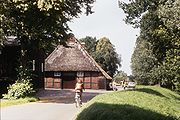
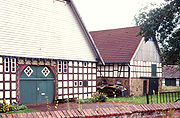
Dreiständerhaus
The intermediate variant is the Dreiständerhaus or three-post farmhouse. This is an asymmetricAsymmetric
Something which is asymmetric displays asymmetry. Specific uses of the term may include:*Asymmetric relation for information on such relations in mathematics and set theory*Asymmetric warfare for information and theories of modern war...
version of the two- and four-post farmhouses, in which the roof ridge is located almost directly over one of the Deele walls. On this side the eaves are like those on the Vierständerhaus, often at the height of the Deele ceiling. On the other side the rafters are arranged like those of a Zweiständerhaus. Often the lower part of the roof is attached on both sides.
Vierständerhaus
The design of the Vierständerhaus or four-post farmhouse is a more comfortable evolutionary development of the Zweiständerhaus built by well-to-do farmers. The building is supported by four rows of uprights arranged longitudinally, of which two form the sides of the Deele and two form the outer walls. So the outsider walls have a load-bearing function. In farmhouses of more affluent farmers there is also a clearer separation between living quarters and animal stalls.Durchgangshaus
In addition to the normal floor plan there are also farmhouses with a large gateway at both gable ends of the building in order to enable carts to be driven through from end to end. In such a Durchgangshaus or through house the layout of the rooms was necessarily diffierent. Even the hearth was not located in the usual place. This variant of the Low German house is often found in HolsteinHolstein
Holstein is the region between the rivers Elbe and Eider. It is part of Schleswig-Holstein, the northernmost state of Germany....
and Mecklenburg-Vorpommern, but also occasionally in Westphalia
Westphalia
Westphalia is a region in Germany, centred on the cities of Arnsberg, Bielefeld, Dortmund, Minden and Münster.Westphalia is roughly the region between the rivers Rhine and Weser, located north and south of the Ruhr River. No exact definition of borders can be given, because the name "Westphalia"...
too.
Roof shapes
In Westphalia all these farmhouses have a gable roof. In parts of Lower Saxony and in Holstein there is a mix of farmhouses with gable and hipped-gable roofs, and in Mecklenburg almost all have hipped-gables. A pure hipped roof is rare.Gable shapes
The original location of the living accommodation in part of the Deele explains the very unusual layout of the Low German house. Whilst other 'all-in-one' farmhouses have their living quarters at the front, the Low German house across most of its native region has its main gateway at the front. The large gateway gable (colloquially: Grotdörgiebel) was very carefully made. The frame and especially the lintel of the Grote Dör (great door) were adorned with inscriptions and decorations. On simple houses the gable above is just filled in with vertical timber laths; on more complicated buildings the timber-framing of the steep gable extends almost to the roof ridge. In the Altes LandAltes Land
Altes Land is an area of reclaimed marshland straddling parts of Lower Saxony and Hamburg. The region is situated downstream from Hamburg on the southwestern riverside of the Elbe around the towns of Stade, Buxtehude, Jork and the Samtgemeinde of Lühe...
projecting gables are preferred. In Schaumburg Land and the area around Hanover the gable is topped by a roof section sloping at about 80°.
The stepped gable on the living room side was only decorated in a few cases, for example, in the Vierlande where it was on the road-facing side.
Internal layout
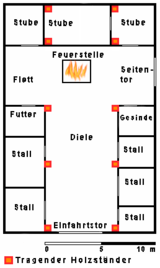
Diele
The largest and most important room in the Low German house was the great central threshing floor, the Diele (Low German: Deele, Del). This was usually entered via the great, rounded door at the gable end, known in Low GermanLow German
Low German or Low Saxon is an Ingvaeonic West Germanic language spoken mainly in northern Germany and the eastern part of the Netherlands...
as the Grote Dör, Groot Dör or Grotendör ("great door"). The door was also the entrance for harvest wagons leading to the Diele which was like a cavernous hall
Hall
In architecture, a hall is fundamentally a relatively large space enclosed by a roof and walls. In the Iron Age, a mead hall was such a simple building and was the residence of a lord and his retainers...
, hence the alternative name for this type of farmhouse, the Hallenhaus ("hall house"). The Diele was formed by the space between the two rows of supporting uprights. With its tamped clay floor it was the working room of the farmhouse. It was here that the harvest
Harvest
Harvest is the process of gathering mature crops from the fields. Reaping is the cutting of grain or pulse for harvest, typically using a scythe, sickle, or reaper...
was gathered before being stored in the hayloft above. It also provided protection from the weather for activities, such as the drying of farm implements, the breaking of flax
Flax
Flax is a member of the genus Linum in the family Linaceae. It is native to the region extending from the eastern Mediterranean to India and was probably first domesticated in the Fertile Crescent...
, the spinning
Spinning (textiles)
Spinning is a major industry. It is part of the textile manufacturing process where three types of fibre are converted into yarn, then fabric, then textiles. The textiles are then fabricated into clothes or other artifacts. There are three industrial processes available to spin yarn, and a...
of textiles or the threshing
Threshing
Threshing is the process of loosening the edible part of cereal grain from the scaly, inedible chaff that surrounds it. It is the step in grain preparation after harvesting and before winnowing, which separates the loosened chaff from the grain...
of grain. Celebrations, too, were held in the hall and recently deceased members of the family were laid out here. To both sides of the Diele were the half-open stalls or stables (Kübbungen) for cattle or horses, as well as chambers for the maid
Maid
A maidservant or in current usage housemaid or maid is a female employed in domestic service.-Description:Once part of an elaborate hierarchy in great houses, today a single maid may be the only domestic worker that upper and even middle-income households can afford, as was historically the case...
s and farmhands. Poultry
Poultry
Poultry are domesticated birds kept by humans for the purpose of producing eggs, meat, and/or feathers. These most typically are members of the superorder Galloanserae , especially the order Galliformes and the family Anatidae , commonly known as "waterfowl"...
would be kept near the entrance way at the edges of the hall. From the outset pigs were banished to separate sheds outside the building due to their smell. Only when living quarters and the Diele area were fully separated from one another could pigs also be encountered in the hall. The Diele opened out into the open eating and kitchen area, the so-called Flett.
Flett

Fieldstone
Fieldstone is a building construction material. Strictly speaking, it is stone collected from the surface of fields where it occurs naturally...
s. It was not like a hearth in other regions. Many types of cooking were not possible in this environment (*). Pots had to be high enough, in effect cauldron
Cauldron
A cauldron or caldron is a large metal pot for cooking and/or boiling over an open fire, with a large mouth and frequently with an arc-shaped hanger.- Etymology :...
s, and were hung over the fire with pothooks attached to a wooden frame (Rahmen) hanging over the fireplace, often decorated with horses heads. At night an iron grid was pulled over the fire to prevent sparks, a practice known by the English term curfew. Well-to-do families had a candle arch (Schwibbogen) of masonry instead of a wooden frame. Smoke escaped through an opening in the roof on the gable, the Uhlenloch (also Eulenloch, literally: "owl hole"). The open fireplace meant that such buildings were considered as a particular fire risk by early fire insurance firms. The open fire also provided some heat to the stalls and living quarters of the Hallenhaus. In this way, hay stored in the loft could be dried out and protected from vermin
Vermin
Vermin is a term applied to various animal species regarded by some as pests or nuisances and especially to those associated with the carrying of disease. Since the term is defined in relation to human activities, which species are included will vary from area to area and even person to person...
by the smoke. When the farmer's family and farm hands gathered for meal times, the best places were between the fireplace and the rooms. Because there was no partition between Diele and loft, winter temperatures in the Flett never rose above 12 °C.
A subsequent improvement was the extraction of smoke through a flue
Flue
A flue is a duct, pipe, or chimney for conveying exhaust gases from a fireplace, furnace, water heater, boiler, or generator to the outdoors. In the United States, they are also known as vents and for boilers as breeching for water heaters and modern furnaces...
. Still later, a proper hearth would be added with a stone chimney. This made cooking easier and meant that the house was now free of smoke. On the down side, the hearth was no longer really a source of light and there was less energy for heating the house. Later still, one of the larger rooms would be built as a parlour with a separate stove
Stove
A stove is an enclosed heated space. The term is commonly taken to mean an enclosed space in which fuel is burned to provide heating, either to heat the space in which the stove is situated or to heat the stove itself, and items placed on it...
heated from the Diele.
When the division of rooms was fundamentally changed in the 19th century, a separate kitchen was established in the living accommodation at the back of the farmhouse. So the farmhouse, which had been divided longitudinally for such a long time, now had its different functions arranged transversely across the building.
(*) Bread was baked outside the farmhouse Hauses in an earth or stone oven. In northwest Germany this only had one chamber. It was first heated, then the embers were raked out and the loaves pushed inside, in order to be baked by the heat stored in the sides of the oven.
Living quarters
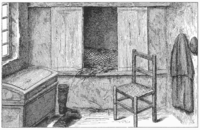
Basement
__FORCETOC__A basement is one or more floors of a building that are either completely or partially below the ground floor. Basements are typically used as a utility space for a building where such items as the furnace, water heater, breaker panel or fuse box, car park, and air-conditioning system...
under the Kammerfach, but it was not very deep. The separate living quarters were raised above the level of the main hall as if on a plinth and in the larger four-post farmhouses (Vierständerhäuser) sometimes formed a sort of gallery.
Decoration
The most eye-catching decoration of the otherwise drab Fachhallenhaus is found on the point of the gables and consists of carved wooden boards in the shape of (stylised) horses' heads. The boards do serve a constructional purpose in that they protect the edges of the roof from the wind. The horses' heads are attributed to the symbol of the Saxons, the Saxon SteedSaxon Steed
The Saxon Steed is a favorite heraldic motif of the Saxons.-Origin and past uses:The Saxon Steed originated in the tribal Duchy of Saxony...
. Its distribution as decoration on roof ridges is also reflected in the coats of arms of several north Germany towns and villages. In some regions, e. g. in the Hanoverian Wendland, the gable points often have an artistically turned post instead, the so-called Wendenknüppel.
Other decorations or mottos are usually found as inscriptions over the entranceway. The lintel gives the name of the builder, the year the house was built and often another saying. Occasionally modest decorations are found on the timber framed, front gable. They are designed into the brickwork of the panels and portray, for example, windmills, trees or geometric figures

Decline
By the end of the 19th century this type of farmhouse was outmoded. What was once its greatest advantage - having everything under a single roof - now led to its decline. Rising standards of living meant that the smells, breath and manure from the animals was increasingly viewed as unhygienic. In addition the living quarters became too small for the needs of the occupants. Higher harvest returns and the use of farm machinery in the GründerzeitGründerzeit
' refers to the economic phase in 19th century Germany and Austria before the great stock market crash of 1873. At this time in Central Europe the age of industrialisation was taking place, whose beginnings were found in the 1840s...
led to the construction of modern buildings. The old stalls under the eaves were considered too small for today's cattle. Since the middle of the 19th century fewer and fewer of these farmhouses were built and some of the existing ones were converted to adapt to new circumstances. Often the old buildings were torn down in order to create space for new ones. In the original region where once the Low German house was common, it was increasingly replaced by the Ernhaus whose main characteristic was a separation of living quarters from the livestock sheds.
Present-day situation
The Low German house is still found in great numbers in the countryside. Most of the existing buildings have however changed over the course of the centuries as modifications have been carried out. Those farmhouses that have survived in their original form are mainly to be found in open air museumOpen air museum
An open-air museum is a distinct type of museum exhibiting its collections out-of-doors. The first open-air museums were established in Scandinavia towards the end of the nineteenth century, and the concept soon spread throughout Europe and North America. Open-air museums are variously known as...
s like the Westphalian Open Air Museum at Detmold
Detmold
Detmold is a city in North Rhine-Westphalia, Germany, with a population of about 74,000. It was the capital of the small Principality of Lippe from 1468 until 1918 and then of the Free State of Lippe until 1947...
(Westfälisches Freilichtmuseum Detmold) and the Cloppenburg Museum Village (Museumsdorf Cloppenburg). The latter has set itself the task of uncovering rural historic buildings in Lower Saxony and documenting the most important examples accurately. For the state of Schleswig-Holstein the Schleswig-Holstein Open Air Museum (Schleswig-Holsteinisches Freilichtmuseum) in Kiel-Molfsee is the most important one with its large collection of Fachhallenhäuser and the like. Several of these buildings may also be found at the Kiekeberg Open Air Museum (Freilichtmuseum am Kiekeberg
Kiekeberg
The Kiekeberg is, at 127 metres above sea level, one of the more prominent hills in the Harburg Hills in north Germany. It is located in the parish of Ehestorf in the municipality of Rosengarten in the district of Harburg in the southern foothills of the range, which is also known as The Black...
) and the Volksdorf Museum Village (Museumsdorf Volksdorf) in Hamburg; Examples from the eastern part of the Hallenhaus region are displayed in the Schwerin-Kueß Open Air Museum (Freilichtmuseum Schwerin-Mueß).
At the end of the 20th century old timber-framed houses, including the Low German house, were seen as increasingly valuable. As part of a renewed interest in the past, many buildings were restored and returned to residential use. In various towns and villages, such as Wolfsburg-Kästorf, Isernhagen
Isernhagen
Isernhagen is a municipality in the district of Hanover, in Lower Saxony, Germany. It is situated right next to Hanover. Bundesautobahn 7 passes through the municipality.-Division of the municipality:Isernhagen consists of 7 districts:...
and Dinklage
Dinklage
Dinklage is a town in the district of Vechta, in Lower Saxony, Germany. It is situated approx. 13 km southwest of Vechta, and 45 km north of Osnabrück.-History:...
, new timber-framed homes were built during the 1990s, whose architecture is reminiscent of the historic Hallenhäuser.
Sources
- Richard AndreeRichard AndreeRichard Andree was, like his father Karl Andree, a German geographer noted for devoting himself especially to ethnography...
: Braunschweiger Volkskunde. Braunschweig 1901. - Karl Baumgarten: Das deutsche Bauernhaus, eine Einführung in seine Geschichte vom 9. bis zum 19. Jh. Berlin 1980, ISBN 3529026522
- Karl Baumgarten: Das Bauernhaus in Mecklenburg. Akademie-Verlag, Berlin 1965, 1970 (Neuaufl. u. d. Titel „Hallenhäuser in Mecklenburg“.)
- Karl Baumgarten: Landschaft und Bauernhaus in Mecklenburg. Berlin 1995, ISBN 3-345-00051-2
- Konrad Bedal: Ländliche Ständerbauten des 15. bis 17. Jahrhunderts in Holstein und im südlichen Schleswig. Wachholtz, Neumünster 1977, ISBN 3-529-02450-3
- Frank Braun, Manfred Schenkenberg: Ländliche Fachwerkbauten des 17. bis 19. Jahrhunderts im Kreis Herzogtum Lauenburg. Wachholtz, Neumünster 2001, ISBN 3-529-02597-6
- Carl Ingwer Johannsen: Das Niederdeutsche Hallenhaus und seine Nebengebäude im Landkreis Lüchow-Dannenberg. Dissertation. Braunschweig 1973.
- Horst Lehrke: Das niedersächsische Bauernhaus in Waldeck (Beiträge zur Volkskunde Hessens, Band 8). 2. Auflage, Marburg 1967
- Werner Lindner: Das niedersächsische Bauernhaus. Hannover 1912.
- Willi Pessler: Das altsächsische Bauernhaus. Braunschweig 1906.
- Josef Schepers: Haus und Hof westfälischer Bauern. 7., neubearb. Auflage, Münster 1994.
External links
- Farmhouses in Lower Saxony (main focus on the Fachhallenhaus with distribution map, photographs and sketches - German)
- Description of the building by the Cloppenburg Museumsdorf - German
- Floor plan at Fachwerk-Lehmbau.de - German
- Timber framed and Fachhallenhaus buildings in Altes Land (Stade) - German
- Bielefeld Farmhouse Museum - German
- A Low German house in the Weser-Ems region - German

